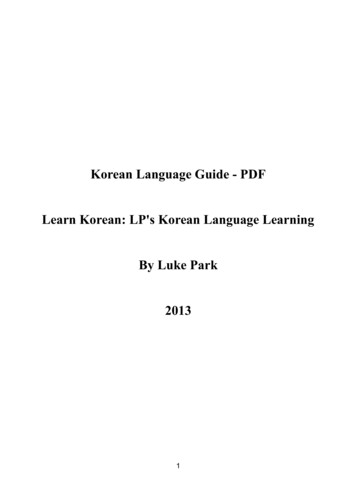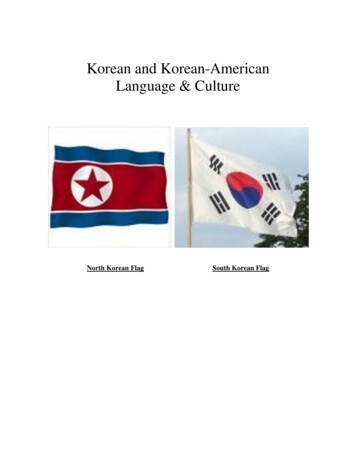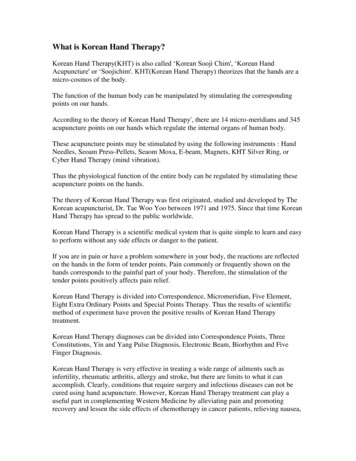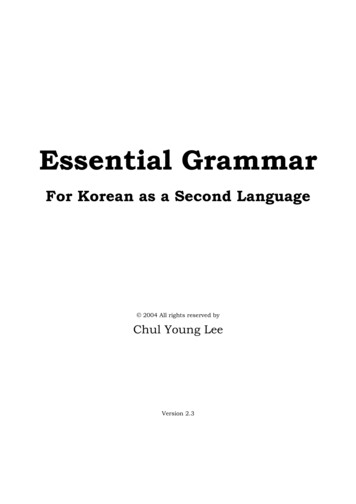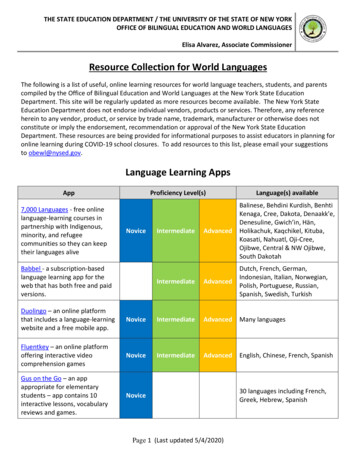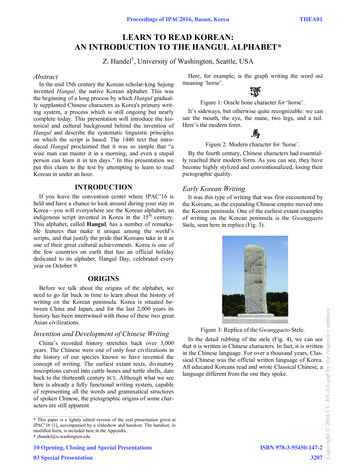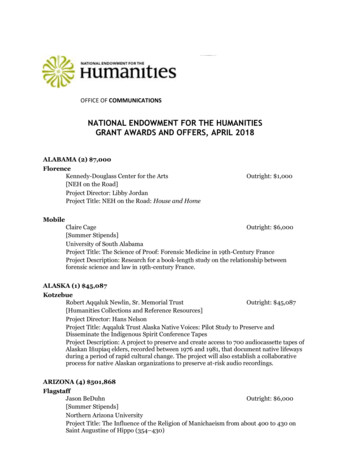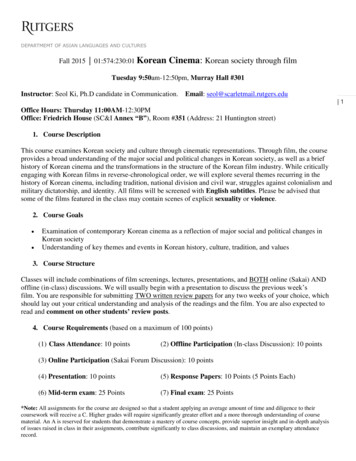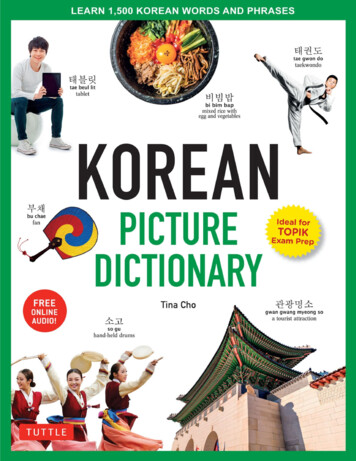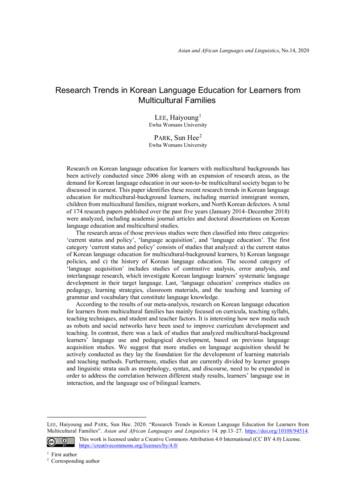
Transcription
Asian and African Languages and Linguistics, No.14, 2020Research Trends in Korean Language Education for Learners fromMulticultural FamiliesLEE, Haiyoung 1Ewha Womans UniversityPARK, Sun Hee 2Ewha Womans UniversityResearch on Korean language education for learners with multicultural backgrounds hasbeen actively conducted since 2006 along with an expansion of research areas, as thedemand for Korean language education in our soon-to-be multicultural society began to bediscussed in earnest. This paper identifies these recent research trends in Korean languageeducation for multicultural-background learners, including married immigrant women,children from multicultural families, migrant workers, and North Korean defectors. A totalof 174 research papers published over the past five years (January 2014–December 2018)were analyzed, including academic journal articles and doctoral dissertations on Koreanlanguage education and multicultural studies.The research areas of those previous studies were then classified into three categories:‘current status and policy’, ‘language acquisition’, and ‘language education’. The firstcategory ‘current status and policy’ consists of studies that analyzed: a) the current statusof Korean language education for multicultural-background learners, b) Korean languagepolicies, and c) the history of Korean language education. The second category of‘language acquisition’ includes studies of contrastive analysis, error analysis, andinterlanguage research, which investigate Korean language learners’ systematic languagedevelopment in their target language. Last, ‘language education’ comprises studies onpedagogy, learning strategies, classroom materials, and the teaching and learning ofgrammar and vocabulary that constitute language knowledge.According to the results of our meta-analysis, research on Korean language educationfor learners from multicultural families has mainly focused on curricula, teaching syllabi,teaching techniques, and student and teacher factors. It is interesting how new media suchas robots and social networks have been used to improve curriculum development andteaching. In contrast, there was a lack of studies that analyzed multicultural-backgroundlearners’ language use and pedagogical development, based on previous languageacquisition studies. We suggest that more studies on language acquisition should beactively conducted as they lay the foundation for the development of learning materialsand teaching methods. Furthermore, studies that are currently divided by learner groupsand linguistic strata such as morphology, syntax, and discourse, need to be expanded inorder to address the correlation between different study results, learners’ language use ininteraction, and the language use of bilingual learners.LEE, Haiyoung and PARK, Sun Hee. 2020. “Research Trends in Korean Language Education for Learners fromMulticultural Families”. Asian and African Languages and Linguistics 14. pp.13–27. https://doi.org/10108/94514.This work is licensed under a Creative Commons Attribution 4.0 International (CC BY 4.0) 0/12First authorCorresponding author
14Asian and African Languages and Linguistics 14Keywords: Korean language education, multicultural families, married immigrant women, migrant workers, NorthKorean defectors, meta-analysis1. Introduction2. Review of previous studies3. Methodology4. Research trends in Korean language education for multicultural-background learners5. Conclusion1. IntroductionResearch on Korean language education for learners with multicultural backgrounds hasbeen actively conducted as the increasing demand for Korean language education in ourmulticultural society began to be discussed in earnest.This paper groups married immigrant women, children from multicultural families,migrant workers, and North Korean defectors, considering them all “multiculturalbackground learners”, and identifies the recent research trends targeting these groups. Thestudies reviewed in this paper are also categorized into three types in a meta-analysis:‘current status and policy’, ‘language acquisition research’ and ‘language educationresearch’. There are three general topics which have shaped the field of languageacquisition research: interlanguage studies, contrast analysis between learners’ mothertongue and target language, and analysis of errors occurring in second language learning.The language education research consists of studies on pedagogical issues and strategiesfor learning grammar, vocabulary, discourse, and pragmatics of the Korean language. Italso encompasses studies on curricula, syllabi, textbook analysis, and textbookdevelopment.Based on the results of a meta-analysis, this paper aims to address the researchachievements and limitations of previous studies and to suggest possible improvements thatcan be made in Korean language classrooms and Korean language education policy.2. Review of previous studiesWith the accumulation of research papers on multicultural-background learners, therehave been many efforts to evaluate previous literature. Previous studies have usually beencategorized by research topic and sorted into the categories of pedagogy, curriculum, andeducation policy. In some previous studies, e.g., Sim (2014), the term ‘multiculturalbackground learners’ has been expanded to embrace international marriage families,migrant workers, and North Korean defectors. However, the focus of most studies has beenfixated on married immigrant women or children from multicultural families. Many
LEE and PARK: Research Trends in Korean Language Education for Learners from Multicultural Families15previous studies have also discussed the development of new education programs, the useof qualitative research methods, learners with more diversified linguistic backgrounds, andapplications of the study results in classrooms (Kang 2015). Among these studies, however,only a few have looked at the process of Korean language acquisition for multiculturalbackground learners. As a result, there has been a lack of discussion about curriculumdevelopment based on the characteristics of learners’ interlanguage and actual language usein their daily interactions with Korean native speakers. In response, this paper aims toreview the previous studies in detail in order to identify recent research trends in Koreanlanguage education for multicultural-background learners and to underscore the need foran increase in both the quantity and quality of studies on multicultural-background learners’Korean language acquisition.3. MethodologyThis paper analyzes a total of 174 studies 3 including academic journal articles anddoctoral dissertations 4 published in Korean language education over the past five years,from January 2014 to December 2018.The research topics discussed in these previous studies were classified into threecategories: ‘current status and policy’, ‘language acquisition’, and ‘language education’.The research on current status and policy focuses on topics such as Korean languageeducation practices for multicultural-background learners, current Korean languageeducation policies, and research trends in Korean language education (see ① in Table 1).The language acquisition research includes studies of contrast analysis, error analysis, andinterlanguage research, which investigates Korean language learners’ systematic languagedevelopment in their target language (②). Last, the language education research comprisesstudies on the teaching and learning of language knowledge (③), pedagogy (④), andclassroom materials (⑤).The keywords used with the search term ‘Korean language’ on the Research Information Service System (RISS)provided by the Korea Education and Research Information Service (KERIS) were ‘multicultural’, ‘married immigrant’,‘social integration’, ‘immigrated children’, and ‘North Korean defectors’, in order. On overseas databases,‘multicultural’ and ‘Korean’ were used together to search for relevant studies.4Some previous studies have analyzed either academic journal articles (Won and Kim 2015, etc.) or dissertations (Kim,Y. 2017, etc.). This paper reviews both journal articles and doctoral dissertations published in the past five yearsincluding 2018.3
16Asian and African Languages and Linguistics 14Table 1CategoryCurrent status and policyLanguage acquisitionLanguage education①②③④⑤Categories of research topicsResearch Topicpractices, policy, research trendscontrast analysis, error analysis, interlanguage researchteaching and learning of grammar, pronunciation,vocabulary, discourse and pragmaticscurricula, syllabi, teaching techniques, student and teacherfactorstextbook analysis, textbook development, foundationstudies 54. Research trends in Korean language education formulticultural-background learners4.1. Research subjectsAn analysis of the research subjects examined in previous research indicates that themajor research subject group has been children from multicultural families with just a fewstudies on North Korean defectors.Table 2Children frommulticultural familiesAcademicjournal articleResearch subjectsDoctoral dissertationTotal8959%1045%9957%Married immigrants3322%627%3922%North Koreandefectors64%00%63%Migrant 4100%6Total4.2. Research topicsA review of the research topics revealed that most studies focused on curricula, syllabi,teaching techniques, and student and teacher factors (④). Following the topics listed in ④,other studies concentrated on practices, policy, and research trends (①), or textbookanalysis, textbook development, and foundation studies (⑤).Foundation studies refers to studies that reviewed existing textbooks and vocabulary lists in comparison to those usedfor other language education (Noh 2018; Kim 2016), or that discussed Korean honorific education (Choi 2018) orcontent-based Korean culture education (Oh 2017).6The research papers that take a more holistic perspective in studying two or more subject groups are included here.Most of the studies in “Other” category studied children and married immigrants from multicultural families together.Other studies included diverse groups as their research subjects.5
LEE and PARK: Research Trends in Korean Language Education for Learners from Multicultural FamiliesTable 3Research TopicCurrent statusand policypractices, policy,research trendsLanguageacquisitioncontrast analysis,error analysis,interlanguage researchLanguageeducationteaching and learning ofgrammar,pronunciation,vocabulary, discourseand pragmaticscurricula, syllabi,teaching techniques andstudent and teacherfactorstextbook analysis,textbook developmentand foundation studiesTotalResearch topicsAcademicjournal 100%22100%174100%4.3. Research trends for each topicWe subcategorized the research trends in Korean language education for multiculturalbackground learners as below; (1) Practices, policy and research trends, (2) contrastanalysis, error analysis, interlanguage research, (3) teaching and learning of grammar,pronunciation, vocabulary, discourse and pragmatics, (4) curricula, syllabi, teachingtechniques and student and teacher factors and (5) textbook analysis, textbook developmentand foundation studies.4.3.1. Practices, policy and research trendsThe information about recent studies on practices, policy, and research trends is shownin Table 4.Table 4PracticesPolicyResearchtrendsTotalResearch on practices, policy, and research trendsAcademicjournal article1753%825%Doctoral 0%6100%38100%Many of these studies that focused on the practices of Korean language educationtargeting multicultural-background learners proposed suggestions for language institutions
18Asian and African Languages and Linguistics 14and current Korean language education policy (Lee 2014). 7 In addition, studies have alsolooked at bilingual language education at home (Ho Thi Long An 2018; Kwon and Lee2018) as well as school curricula and teaching and learning practices in the classroom (Leeand Kim 2018; Sohn 2017; Mo et al. 2015). The research papers dealing with languagepolicy addressed the strengths and weaknesses of Korean language education policy bycomparing it with that of other countries (Won 2014; Oh 2016; Lee et al. 2018). They alsoconducted a thorough analysis of government projects, such as the Social IntegrationProgram, to discuss recommendations for rectifying current issues (Yoon and Lee 2018;Choi 2018). 8Other studies underscored that bilingual language education at home helps children ofmulticultural families cultivate self-esteem for their parent’s cultural background andpromote a positive attitude towards their personal relationships with friends and family(Shin 2010; Cho and Kim 2013). A survey showed that 78% of married immigrant womenhave not yet used their language as a medium for bilingual language education, despitereporting that many of them want to teach their children their first language (Seong andHan 2011). Despite the efforts of the Ministry of Justice and Ministry of Gender Equalityand Family, 9 not many schools are able to provide bilingual language education. Even ifthey do provide such programs, the lesson hours are too short, since there are not enoughteachers or teaching materials including textbooks for bilingual language education. As aconsequence, these under-resourced bilingual education programs have resulted in a lackof public understanding of immigrant cultures (Ho Thi Long An 2018).In order to address this dilemma, some studies have analyzed previous research tosuggest solutions 10 that could improve the quality of Korean language education formulticultural-background learners (Sim 2014; Won and Kim 2015; Kim, Y. 2017).7The suggestions made from Lee (2014: 258) are as follows; (1) developing a teacher training program to supportteachers to build up their professional competence; (2) cultivating professional personnel qualified both in teachingKorean and curriculum education; (3) fostering a future-oriented leadership of school principals; and (4) conductingfamily literacy education programs to involve parents into school education and improve quality of life.8Yoon and Lee (2018) pointed out the current issues regarding the Social Integration Program as below; (1) Koreanlanguage and culture education should continue from beginning to advanced level and the content of education shouldbe specialized according to the learners’ education level, (2) some policies in Social Integration Program focused oncertain groups should be reexamined, and (3) the education should be specialized based on the learners’ length andpurpose of stay in Korea.9The Korean government issued the ‘Measures for Advancing Education for Multicultural-Background Learners’ in2012 (Lee and Kwon 2018). With the government’s determination to reinforce bilingual language education, thiscaptured the public’s attention on the issue of the bilingual language education of multicultural families.10The proposals made in the studies are as follows; a variety of research topics should be introduced in the fields ofboth Korean language education and KSL (Korean as Second Language)/KFL (Korean as Foreign Language) educationfor multicultural learners and the multiple research methods also should be introduced to improve validity and reliabilityof Korean language education (Sim, 2014). In order to establish theoretical foundation on multicultural education, futurestudies need to focus on content-based language teaching for middle and high school students apart from traditionalinterest on pedagogy and language education policy which includes language skills, grammar, vocabulary and culture(Kim, Y. 2017).
LEE and PARK: Research Trends in Korean Language Education for Learners from Multicultural Families194.3.2. Contrast analysis, error analysis, interlanguage researchThe studies shown in Table 5 were categorized as language acquisition research; thesestudies discussed the interlanguage characteristics found in the language use ofmulticultural-background learners, compared the different language usage of Koreanlanguage learners and native speakers, and addressed errors occurring in the learners’language learning process. The interlanguage of multicultural-background learners hasbeen at the center of language acquisition research, and both research papers on erroranalysis and contrast analysis were frequently conducted during the period underinvestigation.Table 5Research on contrast analysis, error analysis, interlanguage researchTotalAcademicjournal articleDoctoral 63%13100%3100%16100%The topics of language acquisition research cover the acquisition of grammar,pronunciation, vocabulary, and discourse and pragmatics, with an emphasis on learners’acquisition process of the target language discourse and pragmatics. These papers mainlylooked at the various speech act realizations of married migrant women and observed howtheir attitude toward using politeness changes when using the Korean language (Bang 2015;Hong 2016; Chung 2017). Other papers compare the different speech act realizations ofNorth Korean defectors and South Korean native speakers (Jeon 2017; Lee et al. 2018;Yang 2018). 11 Choi (2015) specifically examined children’s writing at the discourse levelregarding grammar acquisition. Hwang (2015) and Ju (2018a) addressed various aspects ofthe types of errors that occurred in the usage of Korean postpositional particles and endings.Park (2014) and Ju (2018b, 2018c) investigated the interlanguage development of learners.Park (2014), in particular, found a positive correlation between married immigrantwomen’s accurate use of Korean auxiliary predicates and their children’s accurate use.When analyzing learners’ writing, researchers also studied how the learners apply Koreangrammar and vocabulary to be pragmatically appropriate at the discourse level (Kim 2015;Cho 2018). Kim (2018) studied Vietnamese learners’ mispronunciation of Koreanconsonants.11Jeon (2017) and Yang (2018) investigated the differences between South Korean (SK) and North Korean (NKR)language use and concluded that NKR speakers preferred direct speech acts and expressions to indirect ones. Lee et al.(2018) argued that rejection strategies and certain expressions used only in North Korea could cause potentialcommunication breakdowns between these two different groups.
20Asian and African Languages and Linguistics 14The most popular subject of research has been students with multicultural backgrounds.Kim, Y. (2017) highlighted the need for more research on learner characteristics and thelinguistic competence of multicultural students. She also argued that future research needsto expand its focus to include subjects who are multicultural students and immigrantchildren in middle school and high school, in order to further the ongoing discussion ofelementary school students from multicultural families. Kim, Y. (2017) then argues that allthe grammar, discourse structure, learning strategies, and vocabulary need to be addressedand studied for academic Korean language education and academic literacy.While some studies report that the linguistic performance of children of marriedimmigrant women is positively correlated to their mothers’ Korean proficiency (Choi andHwang 2009), more research on children’s language use in interactions with their Koreannative-speaker parents should be conducted. This research can be improved by looking atthe interactions between Korean spouses and their immigrant partners.4.3.3. The teaching and learning of grammar, pronunciation, vocabulary, anddiscourse and pragmaticsThe studies in Table 6 include research papers on multicultural-background learners’knowledge of the Korean language. As shown in Table 6, very few papers have dealt withthis topic and thus far none of them has studied learners’ understanding of Korean discourseand pragmatics.Table 6Research on the teaching and learning of grammar, pronunciation, vocabulary,and discourse and pragmaticsGrammarPronunciationVocabularyDiscourse andpragmaticsTotalAcademicjournal article450%112%338%Doctoral 0%00%8100%Table 6 presents the studies that have investigated learners’ linguistic knowledge onKorean. They have drawn various conclusions on conducting grammar classes (Park 2016),teaching the predicate structure of the Korean language (Lee and Jo 2014), the endings ofa dialect used in Andong city (Kwon 2016), and complementizers of Korean noun phrases(Oh 2017). Three studies dealt with vocabulary education; these studies introducevocabulary learning strategies for married immigrant women and North Korean defectors(Park 2018; Kang 2017; Shin and Kim 2014). It is noteworthy that the researchers carefullymade their suggestions on the basis of their observations of the learners’ language use, inorder to help the learners overcome specific difficulties during their process of languageacquisition. Park (2018) suggested that vocabulary education for multicultural students
LEE and PARK: Research Trends in Korean Language Education for Learners from Multicultural Families21should include instruction of words used in school newsletters. Kang (2017) examinedseveral effective teaching methods using images on Google. Shin and Kim (2014) foundthat North Korean defectors struggle with foreign words in the Korean language andproposed a possible learning strategy employing long-term memory. For pronunciationeducation, Cho and Cho (2018) described how pronunciation and intonation education hasbeen conducted in the classroom for multicultural-background learners. More researchshould be conducted, as many married immigrant women experience miscommunicationsdaily, due to inaccurate pronunciation and/or unnatural intonation.Even though the discussion of multicultural-background learners’ acquisition of Koreandiscourse and pragmatics has actively progressed in the research field of languageacquisition, it has barely been applied in classrooms.4.3.4. Curricula, syllabi, teaching techniques, and student and teacher factorsAs previously mentioned, many research papers have mainly focused on teachingtechniques for Korean language education targeting multicultural-background learners.Discussion about the development of curricula, syllabi, and learner and teacher factors hasalso been advanced as shown in Table 7.Table 7Research on curricula, syllabi, teaching techniques, and student and teacher factorsTeachingtechniquesCurricula andsyllabiStudent factorsTeacher factorsTotalAcademicjournal articleDoctoral 121%21%100%421136%18%100%19178223%21%100%The research papers regarding teaching techniques have actively discussed effectivepedagogical approaches for the four types of language skills: listening, speaking, reading,and writing. Many of the papers illustrate the profound effects of the use of media, such asdigital storytelling (Kim and Kim 2018), flipped learning (Hong 2015), robots (Kim andYou 2015), and social network services (Tran Thi Chi 2018), which helped stimulateKorean language learning.Many other studies aim to address possible improvements that can be undertaken toreform the curricula and syllabi used in Korean language education. They mainly focus onexisting curricula and syllabi for second language learners of Korean and analyze howKorean language education for married immigrant women is being practiced in classrooms.In particular, Choi et al. (2018) conducted a needs analysis, which laid a foundation fordesigning and developing a real-time interactive virtual classroom offering Koreanlanguage education for married immigrants. Choi et al. (2018) also expanded their
22Asian and African Languages and Linguistics 14discussion to applications of online sources in classroom. In contrast, Lee (2014) examinedthe ongoing practices of Korean language education for multicultural students inelementary, middle, and high schools. Lee then addressed the importance of teacher trainingsessions and family literacy education that includes both students and parents. The studyalso underlined the significant role of the school principal in training teachers and managingfamily literacy education.The research on student factors investigated the learning motivations of children frommulticultural families and married immigrant women, and examined variables affecting thelearning process. Last, the research on teacher factors discussed the retraining of teachersand teacher management systems in terms of teachers’ awareness of multiculturalism andcompetence for teaching multicultural-background students. These teacher factors werebarely considered in the research field of Korean language education for multiculturalbackground learners before 2014. Since 2015, as researchers have started to recognize thatthe degree of teachers’ understanding of multiculturalism has profound effects onmulticultural-background learners’ school lives (Tak et al. 2014), the research has finallybegun to shed light on the significance of teachers’ competence for working with studentsfrom multicultural families. Researchers therefore need to keep abreast of Korean society’sefforts to integrate multicultural students through Korean language education by payingpersistent attention to how these teacher factors play out in classrooms.4.3.5. Textbook analysis, textbook development, foundation studiesAs shown in Table 8, most of the studies on teaching materials have focused on textbooks.These studies mainly focused on textbook analysis by reviewing the textbooks currentlyused in Korean classes. However, they showed a lack of discussion about the developmentof new textbooks or foundation studies for specific groups of learners.Table 8Research on textbook analysis, textbook development, foundation studiesTotalAcademicjournal articleDoctoral 413%29100%2100%31100%The textbook analysis studies have predominantly analyzed two textbooks: ‘StandardKorean’ and ‘Korean for Married Immigrant Women’, which targeted the children ofmulticultural families and married immigrant women, respectively. Kim, J (2017) haspointed out that ‘Korean for Married Immigrant Women’ has portrayed married immigrant
LEE and PARK: Research Trends in Korean Language Education for Learners from Multicultural Families23women as vulnerable, because they are dependent on their Korean husbands, Koreanacquaintances, or friends who are fluent in Korean.The research on textbook development has suggested modifications based on the resultsof textbook analysis, which demonstrates the demand for new textbooks that deliverspecific information about language knowledge and Korean culture. 12 For example, Shimand Cho (2017) discussed new textbook development for immigrant women, suggestingthat textbooks need to embrace some of the potential stages of these women’s lives aftertheir immigration to Korea, such as giving birth to children, raising them, and enrollingthem in school. Along the same lines, Suh (2015) suggested adding cooking recipes to anew textbook in response to the difficulties that married immigrant women may experiencein the kitchen. In another approach, Bae (2017) proposes teaching Korean folk songs as analternative way to promote the social engagement of children from multicultural families,since many folk songs were traditionally developed and used to express public discontenttowards society.The foundation studies have reviewed existing textbooks and vocabulary lists incomparison to other types of language education (Noh 2018; Kim 2016), while alsocovering the topics of Korean honorific education (Choi 2017) and content-based Koreanculture education (Oh 2017).5. ConclusionBased on its review of academic journal articles and doctoral dissertation papers onKorean language education for multicultural-background learners published from 2014 to2018, this paper has categorized the topics of previous studies into three types: currentstatus and policy, language acquisition, and language education. Its meta-analysis showsthat research trends have shaped a great number of studies on classroom practices,education policy, teaching techniques, and curricula and syllabi. However, there has beena lack of studies on the Korean language acquisition of multicultural-background learners.With this in mind, this paper has highlighted the fact that much research needs to be doneon these learners’ actual language use in their daily lives in order to further discussions ofKorean language education and increase the relevance and effectiveness of the languageeducation for these learners.This lack of language acquisition research also hinders the development of classroommaterials and discussions of pedagogical approaches. Given that multicultural-backgroundlearners must participate in more face-to-face interactions with Korean native speakers than12Shin (2013) discusses the use of Korean literature in the classroom as a measure to alleviate the difficulties faced bymarried immigrant women going through pregnancy in a foreign country and to promote their social engagement,deepening their understanding of Korean culture. A variety of classroom activities have also been introduced in Shimand Kim (2012) including writing a book report, participating in hands-on field trips, and creating a family newsletter.
24Asian and African Languages and Linguistics 14other foreign language learners do, analyses must be expanded to examine learners’pronunciation and knowledge of Korean discourse and pragmatics from a languageacquisiti
4.Research trends in Korean language education for multicultural-background learners. 5.Conclusion. 1.Introduction. Research on Korean language education for learners with multicultural backgrounds has been actively conducted as the increasing demand for Korean language education in our multicultural society began to be discussed in earnest.

